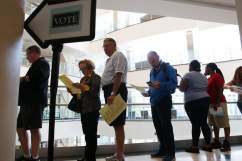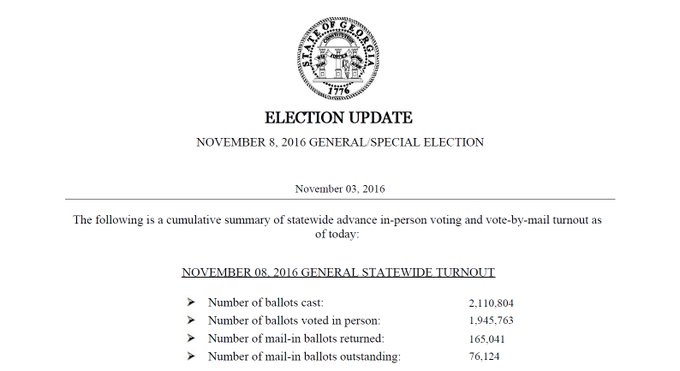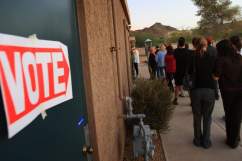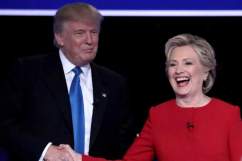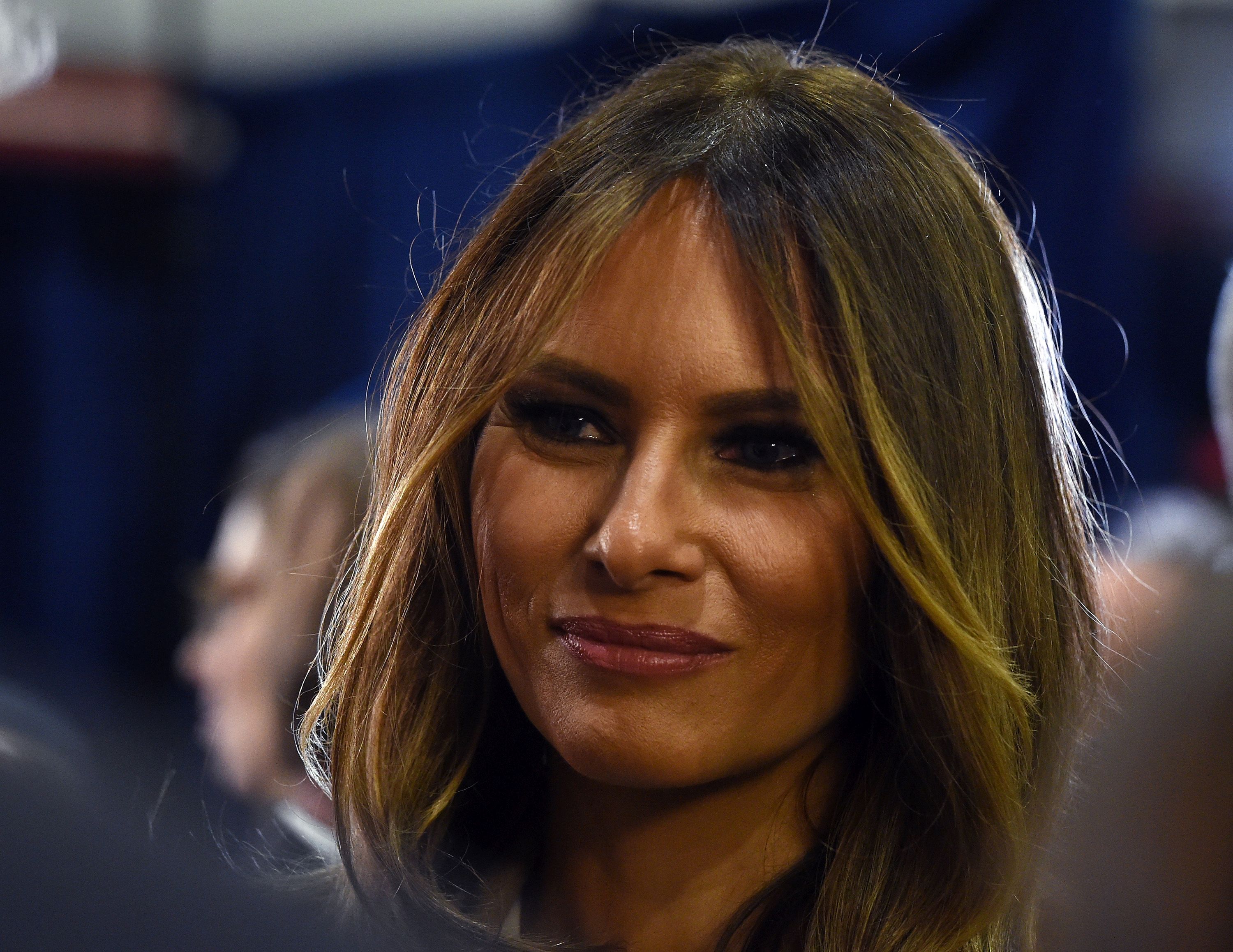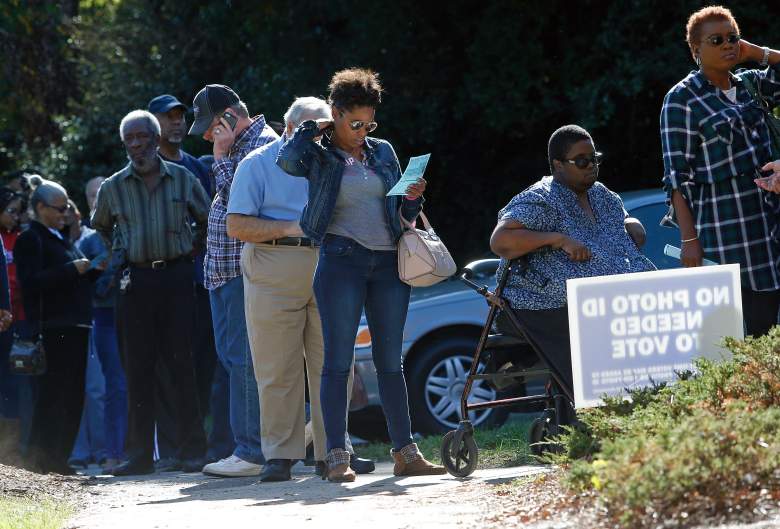
North Carolina early voters wait in line to cast their ballots. (Getty)
More than 40 million Americans have voted early as of November 5.
Early voting results have shown positives for Republicans in some important swing states, like North Carolina, Iowa, and Florida, where the Democratic proportion of early voting is down compared to 2012. Democrats are performing strongly, though, in other important states, like Nevada, Colorado, and Arizona.
A concern for Democrats, though: A decline in the black vote in early voting tallies in some critical states (like North Carolina and Georgia), since black voters overwhelmingly prefer Hillary Clinton. The black vote is down in 7 key states, according to a Washington Post analysis. The white vote is up in 5 and down in 4. However, blacks vote far more lopsidedly for one side – in this case, Clinton’s.
However, Hispanic turnout is up in some states – like Arizona – which likely helps Clinton (although current polls there favor Trump.) Hispanic turnout is up in seven states; this matters less in states with a small Hispanic vote overall and more in states like Arizona and Nevada with a large one.
Democrats historically lead in in-person early voting, so it’s important to compare returns to 2012.
However, even a mixed bag in the early voting battlegrounds might be good news for Clinton. That’s because Trump needs to prevail in most if not all of the battleground states to have a chance to win. For example, some experts who have analyzed the Nevada returns say they point toward a victory for Hillary Clinton in a state where 69% of the electorate early voted in the last presidential election. It will be very tough for Trump to find a path to victory without Nevada (and other battleground states).
Consider this potential electoral map (Trump has been up in recent Nevada polls, and the North Carolina race is a dead heat):
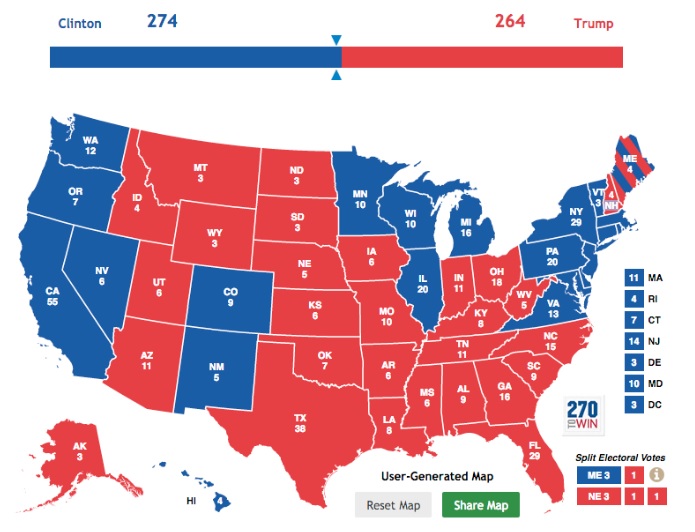
This map, which Heavy created using the RealClearPolitics customizing website for the electoral college, shows how Trump needs to pick up more states even if he does well in states that are virtually tied.
There are questions about how predictive early voting returns can be, of course. States don’t release returns by candidate yet; some do release party affiliation. Independent voters matter, and how they voted can’t be predicted from the early voting tallies. Turnout on election day matters too. Recent polls both in battleground states and nationally have found the race tightening in Trump’s favor in the past week.
Furthermore, not all battleground states allow robust early voting, and Trump seems to be targeting several that do not lately (like Michigan, New Hampshire, and Pennsylvania). Only 5% of the latter state early voted in 2012, and Pennsylvania voters can change their absentee votes besides.
Democrats are banking on early voting to shore up Clinton as Trump gains in the polls. Three national polls released November 4 had the race a literal or virtual tie. Of 9 national polls in the last few days, 2 are a literal tie, 5 are a 3% lead for Clinton or under (within the margin of error for many polls), and 2 showed Clinton with leads outside the margin of error for most polls. Trump does not lead in any of the national polls, though.
In multiple critical battleground states, where the election will be decided, Trump’s polling has continued to improve in recent days. For example, he’s now ahead an average 1.5% in New Hampshire. The past week’s shifts have turned a series of battleground states into virtual ties (North Carolina, Nevada, even potentially Colorado). In other states (like Arizona and Georgia), where he was leading slightly, he strengthened his edge. Most ominously for Clinton, she only leads by an average of 2.6% in Pennsylvania, and the most recent polls there showed the race a tie and Clinton leading by 1 and 2 (Pennsylvania is facing one of the country’s highest Obamacare premium increases, news announced October 24 by the U.S. government).
In 12 of 14 battleground states, Trump improved his standing from October 27 (the day before FBI Director James Comey sent his letter to Congress on Clinton’s emails) and November 2-3. However, a big early voting edge – up from 2012 – in even a few key battleground states could give the election to Clinton. (Here are 7 routes to victory for Clinton in the electoral college, and 7 routes for Trump.)
As of November 4, here are some battleground state break-downs of early voting tallies:
Florida
More Republicans have early voted in Florida than Democrats, although Democrats lead slightly in in-person voting and Republicans by mail, according to the Florida Secretary of State.
By mail:
Republican 985,142
Democrat 910,908
Unaffiliated 414,719
In person:
Republican 1,108,444
Democrat 1,180,845
Unaffiliated 540,584
Republican total 2,093,586 (33.4%)
Democrat total 2,091,753 (33.4%)
Independent percentage (15.6%)
Total early votes/in mail cast (including other): 6,260,236
In 2008, according to CNN, Democrats led Republicans in early voting. Black share of the electorate has dropped since then, although Latino turnout is up, said CNN.
Politico said Democrats led early voting returns in 2012 43% to 40%.
Nevada
Thus far, Democrats have about 40% of the Nevada early vote to about 36% for Republicans and 23% other for week 2 early voting through November 3, according to the Nevada Secretary of State.
The Democrats had an edge in 2012, too. They led 44 percent with Republicans at 37 percent. Obama won Nevada in 2012 52.3% to 45.7%.
To put this in perspective, this Democratic lead is down just a bit from 2012, but not enough to be all that significant. At this point in early voting in 2012, the Democrats were ahead of the Republicans 45 percent to 37 percent.
A KTNV reporter who has been analyzing the early voting results believes it will be very difficult for Trump to overcome the Democratic early voting tallies unless he does extremely well with independents, Clinton doesn’t hold her base, and Trump holds his. It’s unclear which way they will break of course.
The local television reporter, Jon Ralston, has been analyzing early voting returns there and has found that patterns project a Clinton victory.
How certain is Ralston of a Clinton victory after rummaging through all of the early voting data in a state where almost 70% of the electorate early votes? This is what he wrote on November 5, “…the Republicans almost certainly lost Nevada on Friday. Trump’s path was nearly impossible, as I have been telling you, before what happened in Clark County on Friday.” What happened was strong Democratic and Latino turnout.
Ralston noted, “The Dems now have a firewall — approaching 73,000 ballots — greater than 2012 when Barack Obama won the state by nearly 7 points.”
Here’s one scenario through which Trump wins Nevada, according to the reporter: “Both hold 80 percent of base and Trump wins indies by 20: 49-45, Trump.” The reporter concluded, Trump “can win Nevada. But Trump would need base numbers and indie numbers that seem unlikely right now.”
Pennsylvania
According to ABC News, Pennsylvania voters can only vote early by sending in an absentee ballot. They can change their early vote on person on Election Day. The rules are fairly stringent. To vote absentee, Pennsylvania voters must be mentally incapacitated or out of town.
This helps Trump because early voting is not as robust in Pennsylvania; thus more people are voting after polls have tightened there in his favor. In 2012, only 5% of the state cast absentee ballots. (Compare that to a state like Nevada, where 69% of the electorate early votes). Michigan and New Hampshire also do not have wide open early voting and do not have in-person early voting. Numbers for Pennsylvania early voting were not immediately available, but the procedure for doing so is much more restrictive than in some other states where any qualified voter can early vote.
Colorado
The Denver Post’s early ballot tracker shows the Democratic edge over Republicans in early voting has been closing.
As of November 4:
Republicans 547,775 (35.8%)
Democrats 554,340 (36.1%)
Unaffiliated 429,267 (28%)
Total 1,531,382
In 2012, Democrats had 35 percent of early votes and Republicans had 37 percent. So Democratic is up slightly and Republican is down. How independents will break is not known, of course. But the shifting pacing could be good news for Clinton in Colorado where polls are tightening recently.
Obama won Colorado 51.2% to 46.5% in 2012.
North Carolina
In 2012, Democrats had 48 percent of early votes and Republicans had 32 percent. Romney won the state 50.39% to 48.35%.
This year, the North Carolina Secretary of State is reporting the following early voting turnout figures:
Democrat 42.3%
Republican 31.9%
Unaffiliated 25.5%
Libertarian 0.29%
Thus, Republican turnout is fairly level, but Democratic is down since 2012. Turnout among black voters is down this year in North Carolina, and the number of registered Democrats in the state has dropped.
In North Carolina, 17 counties controversially decreased the number of early voting locations, said NBC News; this has resulted in long lines at some polling places and lower early voting tallies. NBC said one county, Guilford County, which houses the largely black city of Greensboro, “cut early voting locations from 16 to just one.” This has resulted in declining early voting totals in North Carolina overall.
Utah
In Utah, 1.5 million people have cast early ballots. According to the Utah Secretary of State:
Republican 720,354
Democrat 176,687
Unaffiliated 615,002
With Democrats making up such a small percentage of the early voters, why are any eyes turning to Utah? It’s because independent candidate Evan McMullin is challenging Trump on the right, and he is from Utah.
However, Trump has recovered in recent polling there and leads in double digits in RealClearPolitics polling averages. Utah has seen a decline in early voting, which some officials attributed to voters still trying to make up their minds in the presidential race.
Georgia
In Georgia, more than 2.1 million early votes have already been cast.
Georgia doesn’t break down early votes by party affiliation. However, as with some other states, Clinton’s concern is that fewer African-Americans are voting early.
According to CNN, as of November 1, 1.5 million votes had already been cast in the state. Of those, 31 percent were from African American voters, a decrease from 36 percent at the same time in 2012.
Iowa
As of November 3, about 535,000 Iowans had cast their ballot early, according to the Iowa Secretary of State’s official report. Democrats hold a lead in votes cast, ahead of Republicans by 42,000 ballots.
However, turnout among Democrats in early voting in Iowa is down more than it is among Republicans, boding well for Trump.
CNN says Iowa early votes by Democrats are about 3 percent off their 2012 pace.
Ohio
In Ohio, officials don’t release party affiliation of early voting but geographic modeling can help make predictions.
Early voting in Democratic areas is less than Barack Obama in 2012, although early voting results for Clinton were slightly better in Ohio than last week.
For example, counties that voted for Mitt Romney in 2012 have seen a 9 percentage increase in early ballot requests compared to 0.8 percent increase for Obama voting counties.
Arizona
According to CNN, Republicans lead in early voting in this traditional Republican state, but by less than they led in 2012.
That’s led Democrats to compete more aggressively in Arizona, although Trump leads in recent polls. CNN did say that Republicans were gaining more ground as early voting continued. However, Hispanic turnout among early voting is up, likely boosting Clinton.
Read more about Donald Trump and Melania in Spanish at AhoraMismo.com:
